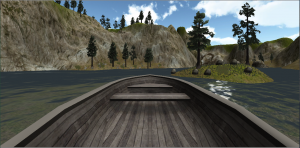The Carolina Mountain Club (CMC), along with other organizations such as the Wilderness Society, have been able to pass through the United States Congress legislation that would ensure the environmental safety of wilderness areas in North Carolina, Tennessee, Georgia, South Carolina, and Virginia. The main acts that saw to this conservation effort were the National Trails System Act and the North Carolina Trails System. Both pieces of legislation deal with wilderness conservation; The National Trails System Act dealt the conservation efforts on a national scale while the North Carolina Trails System handled the conservation efforts of North Carolina. The Carolina Mountain Club has kept several records of both pieces of legislation and through their website, places ways to discover more about the efforts and how they were successful.1)
National Trails System Act
The National Trails System Act was passed on October 2, 1968 by the United States Congress. This act established the standard for trails around the nation including the three different classifications of trails: National Recreation Trails, National Scenic Trails, and Connecting or Side Trails.2) The Secretary of the Interior or the Secretary of Agriculture are the only two labeled in this act that can designate national recreation trails.3) Based up which trail is being classified depends on what can be on the trails (i.e. facilities, signs, etc.). The two main pieces of land that the National Trails System Act dealt with was Appalachian Trail (which was purchased for $5 million) and the Pacific Crest National Scenic Trail (which was purchased for $500,000). According to the Act the Secretary of the Interior has the power to “establish an advisory council for the Appalachian National Scenic Trail” and the Secretary of Agriculture has the power to “establish an advisory council for the Pacific Crest National Scenic Trail.”4)
North Carolina Trails System Act
On October 10, 1972 Jim Holshouser, candidate for the governor of North Carolina was quoted in the Asheville Citizens Times article entitled “Holshouser Vows to Protect Trail” that he would “put forth ‘every effort’ to provide protection for the Appalachian Trail.”5) The trails that Holshouser was referencing were the trails of the Appalachian Trail that were protected against outside forces destroying the natural habitat by the National Trails System Act and the North Carolina Trails System Act. The National Trails System Act led to the inclusion of regulations of trails and what is deemed in the North Carolina Trails System. The North Carolina Trails System was passed on May 22, 1973 by the General Assembly of North Carolina and, according to the act, the purpose of the act was to
“provide for the ever-increasing outdoor recreation needs of an expanded population and in order to promote public access to, travel within, and enjoyment and appreciation of the outdoor, natural, and remote areas of the State, trails should be established in natural, scenic areas of the State, an in and near urban areas.”6)
This act established guidelines that the trails in North Carolina must follow such as how wide a trail should be, who could “create” or designate a trail, what types of trails can be created and the various specific regulations to go along with it, etc. The act was dealt with a number of areas but one of the main pieces of land mentioned in letters from Gerry McNabb, President of the Carolina Mountain Club in 1972, to Del Thorsen, Supervisor of North Carolina Forests, is the Joyce Kilmer-Slickrock Wilderness Area. These areas were seen as great educational areas, especially for botanists, and were preserved as such.
Trail Legislation River Adventure
Have you read the above information? Great! Now it’s time to play a game! Race your way down the river answering questions about the North Carolina Trails System Act and the National Trails System Act. Each time you hit a rock or an invisible barrier the boat will stop and you will be prompted to answer a question. Hit a barrier and get a question right you get points; hit a barrier and get a question wrong and you lose points. Hit a rock and answer a question right and you get points; hit a rock and you get a question wrong you lose points and the health meter of your boat goes down. As the game increases, the questions will get harder. No cheating! And good luck! Trail Legislation River Adventure
References
| ↑1 | 1 “North Carolina’s Mountain Treasures.” Carolina Mountain Club, accessed April 30, 2015, http://www.carolinamountainclub.org/index.cfm/do/pages.view/id/315/page/NC-Mountain-Treasures. |
|---|---|
| ↑2 | 2 US Congress. National Trails System Act. 90th Cong., Carolina Mountain Club Papers Box 16, University of North Carolina Asheville Ramsey Library, Asheville, NC, 1968, 1. |
| ↑3 | 3 US Congress, National Trails Systems Act, 1. |
| ↑4 | 4 US Congress, National Trails Systems Act, 2. |
| ↑5 | 5 Jay Hensley, “Holshouser Vows to Protect Trail,” Asheville Citizen Times, Carolina Mountain Club Papers Box 16, University of North Carolina Asheville Ramsey Library, Asheville, NC. |
| ↑6 | 6 North Carolina Division of Parks and Recreation, Department of Natural Resources and Community Development. North Carolina Trails System Act, Carolina Mountain Club Box 16, University of North Carolina Asheville Ramsey Library, Asheville, NC, 1973, 4. |

